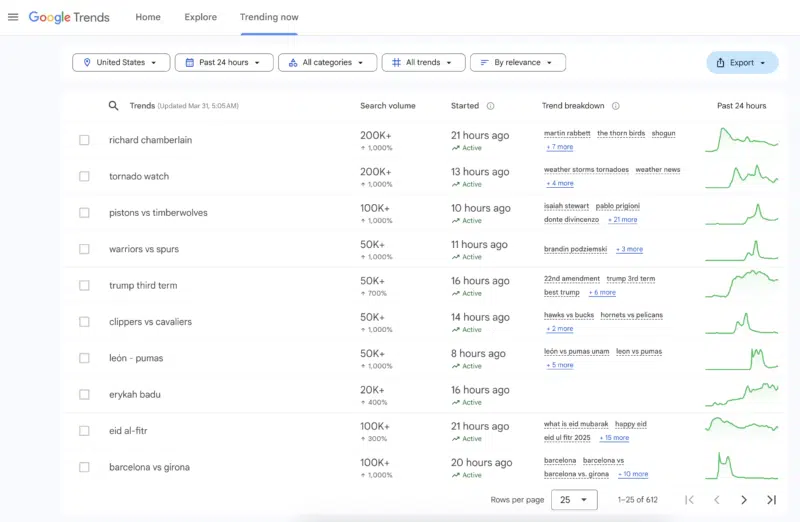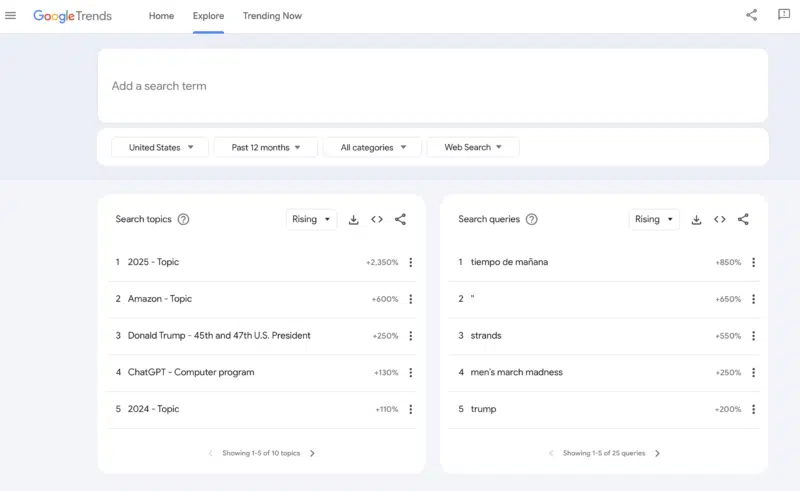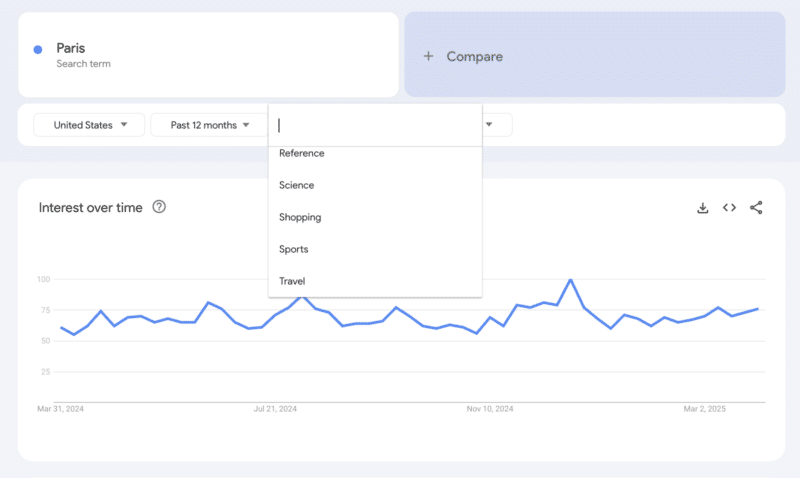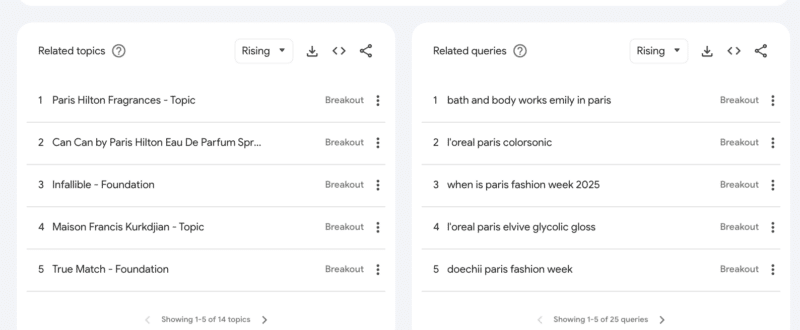Understanding how to use Google Trends data
Google Trends is a tool that shows you what people are searching for on Google. It helps by analyzing search data to reveal the relative popularity of search terms over time and by region.
In this article, you’ll learn how to use Google Trends to understand consumer behavior, optimize your marketing strategies, and gain insights into current and future trends.
Key takeaways
- Google Trends analyzes aggregated search data to reveal consumer behavior trends over time, normalizing data on a 0–100 scale for easy comparison.
- The Trending Now and Explore tools allow users to track emerging trends and conduct in-depth analyses of specific search terms, aiding in timely marketing strategy adjustments.
- Using Google Trends for keyword research and content strategy helps optimize SEO, tailor marketing efforts to regional interests, and plan content around peak consumer search times.
Understanding Google Trends – what is it?
Google Trends analyzes a sample of aggregated and anonymized search data from Google and YouTube to reveal insights into search behaviors over time. By examining search interest for specific topics globally or down to city-level detail, Google Trends helps users identify spikes in interest, allowing marketers and researchers to understand consumer behavior trends and optimize strategies.
Most marketers are used to looking at “monthly search volume” and related absolute values or specific quantities of searches. To characterize what’s trending, Google Trends normalizes data, showing the relative popularity of search terms on a 0–100 scale for easier comparison. This approach focuses on an in-depth understanding of how interest in a specific term fluctuates over time and across different regions.
Navigating Google Trends tools
The two main tools at your disposal are the Trending Now feature and the Explore tool.
- The Trending Now feature identifies the latest rising trends relevant to your industry.
- The Explore Tool allows for a deeper dive into specific search terms and topics, offering a comprehensive analysis of how to get started with trends and their popularity over time.
Using Trending Now
The Trending Now feature is a dynamic tool that keeps you updated with rapidly growing search terms. You can explore rising or top terms and topics, filtering by location, date range, and category. This empowers you to monitor real-time searches to understand what’s timely and how people are talking about it.

Here you can filter and sort based on geography time, search category, and other key characteristics. The “Trend breakdown” drills down into related keywords, which can be handy for your optimization efforts and for seeing how content could fit in to your current pillars and keyword targets.
Imagine noticing a sudden surge in searches related to a major news event or trending topic like climate change. Leveraging this timely information, curated by the trends data team, allows you to tailor your content and marketing efforts to address emerging interests effectively, exploring events in detail.
Similarly, if you know that there’s a certain event or topic that is likely driving large volumes of traffic—like the United States presidential election in 2024—you can verify that using Google Trends. You can also spot geographic hot spots of interest, and even glean related terms.
Exploring with the Explore tool
The Explore Tool is your gateway to deep-dive analyses of specific, individual search terms and topics. You can enter a search term of interest or pick from rising topics and queries.

After you pick your term, Google gives your detailed insights into how and where it’s trending.

Hovering over the Interest Over Time graph reveals the relative number of searches for a term over time, normalized to provide a clear picture of its popularity. This tool is invaluable for understanding how interest in a term evolves and for identifying related searches frequently conducted in the same session.
Remember, this data is normalized on a 1-100 scale. This makes it easier to compare terms and understand their relative popularity, particularly for newer trending terms whose long-term monthly search volume doesn’t capture their importance right now.
For instance, a cheese store owner in the Netherlands might use the Explore Tool to identify which types of cheese are most searched for during different seasons, and this can help them refined their inventory and content calendar accordingly.
Launching your keyword research
Conducting keyword research with Google Trends can significantly enhance your SEO strategy by keeping you aligned with what’s actually relevant to today’s searches. You can ensure the keywords and topics you’re covering match what your target audience wants, and make it easier for Google to surface your website in relevant SERPs. Given how it’s easy for anyone to use Google Trends, this is a powerful tool that can help teams quickly collaborate around content.
Comparing multiple keywords side by side in Google Trends reveals which ones generate more interest, helping you prioritize your content accordingly. This can be very helpful if you have multiple ideas you want to cover, but aren’t sure which one to pick—or just want to verify your hypothesis!
Analyzing keyword popularity trends over the years can also help you identify seasonal trends and peak times for content releases, ensuring your material reaches its audience at the most opportune moments.
Use Google Trends alongside a tool like Semrush to understand long-term keyword interest and gain competitive insights. Simply take the keywords or breakout queries from Google Trends and enter them into Semrush’s tools:
- Keyword Overview → Get search volume, keyword difficulty, CPC, and trend line.
- Keyword Magic Tool → Discover related long-tail keywords.
- Topic Research → Explore content ideas based on trending queries.
- Position Tracking → Monitor how you or competitors are ranking for those trending terms.
- Writing Assistant → Incorporate trending keywords into your content for added optimization.
Crafting a content strategy
Content strategy becomes much more intuitive with Google Trends. Analyzing seasonal search patterns allows you to plan and schedule your content to match consumer interest peaks. For instance, understanding when holiday gift searches spike ahead of the holiday season allows you to prepare and market your products effectively.
Google Trends aids in creating a content calendar by prioritizing topics and identifying seasonal trends. This ensures your content remains relevant and engaging, tailored to align with seasonal interests and audience engagement patterns.
Remember to consider geographic differences when planning your content, as search interest can vary significantly across regions.
Measuring performance
Benchmarking your performance against industry standards is crucial for understanding how well your marketing efforts are working. Google Trends allows you to compare search interest across similar sectors, providing insights into your industry’s performance. For high-volume keywords, it can help you understand which industries are responsible for the volume, and help make sure you’re targeting the right audience.
For example, say you work in Beauty & Fitness and you’re interested in the French girl beauty trend. You see fluctuating interest in the U.S. for “Paris” over time, which could be relevant.

You can select the industry and clarify if this linked to Travel, Shopping, Beauty & Fitness, or even Sports.

By looking at the related terms and topics, you can quickly see how much interest there is in fragrance specifically. Clicking through those terms can reveal that Paris Hilton recently gave an interview and referenced a specific perfume, triggering an uptick in search volume. Just a few easy steps helped you make sense of a trend, leaving you ready to decide whether it would be worth spinning up some related content.
Analyzing search volume fluctuations allows you to measure the effectiveness of your marketing initiatives and make data-driven decisions to improve them.
Geographic data on search term popularity can also aid your local SEO strategies. Identifying areas where specific keywords are trending enables you to allocate your marketing budget more effectively, focusing on regions with higher demand.
Google Search Console, used alongside Google Trends, helps monitor website performance and identify content strategy gaps.
Frequently Asked Questions
How can I use Google Trends for keyword research?
Utilizing Google Trends allows you to identify valuable search terms, compare multiple keywords, and understand seasonal trends, enhancing your SEO strategy effectively. This tool is essential for making informed decisions in your keyword research.
What is the Trending Now feature and how can it benefit my marketing efforts?
The Trending Now feature tracks rapidly growing search terms, allowing you to align your marketing strategies with current consumer interests effectively. By leveraging this tool, you can enhance engagement and drive more relevant traffic to your campaigns.
How do I interpret the Interest Over Time graph in Google Trends?
The Interest Over Time graph in Google Trends indicates the relative popularity of a search term, allowing you to track its changing interest over specific periods. This can help you identify trends and make informed decisions based on the term’s performance.
Can Google Trends be used to monitor brand sentiment?
Absolutely, Google Trends can be effectively used to monitor brand sentiment by analyzing search volume for your business name and related terms over time. This data can provide valuable insights into public perception and trends surrounding your brand.
How can I combine Google Trends with other tools for better insights?
Combining Google Trends with tools like Semrush gives you a well-rounded understanding of audience behavior, allowing you to refine your content strategy effectively. This integration leads to more informed decisions and improved insights.